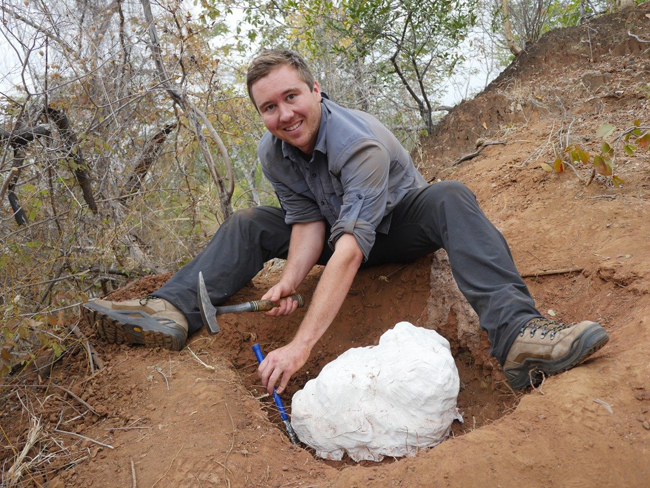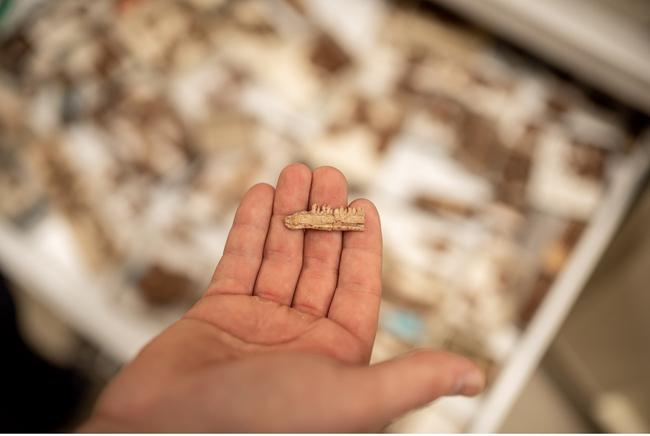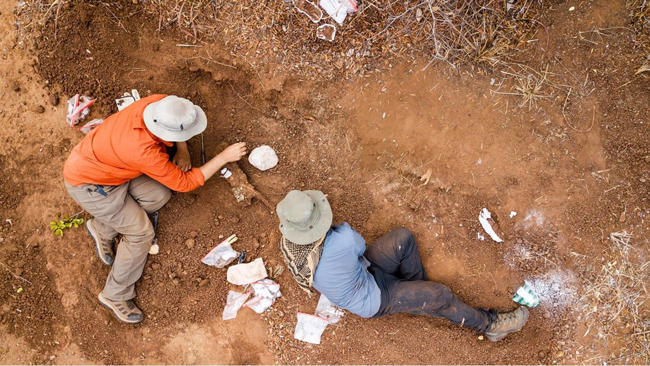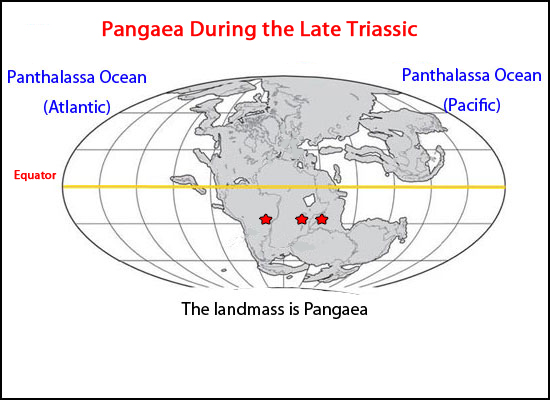New Research Identifies Africa’s Oldest Dinosaur
An international team of scientists have unearthed the remains of Africa’s oldest dinosaur skeleton. The fossils represent a sauropodomorph, which has been named Mbiresaurus raathi. The fossils were excavated from Pebbly Arkose Formation exposures in Mashonaland Central Province, Zimbabwe. This basal sauropodomorph and the associated vertebrate fauna discovered to date is helping scientists to better understand the dispersal and distribution of early dinosaurs and their contemporaries.

Mbiresaurus raathi
The research team led by palaeontologists from Virginia Tech in collaboration with colleagues from the Natural History Museum of Zimbabwe, the Universidade de São Paulo, (São Paulo, Brazil) and the Chipembele Wildlife Education Centre, (Mfuwe, Zambia) have explored the extensive Upper Triassic sandstone exposures of the Pebbly Arkose Formation. As well as finding the nearly complete and articulated sauropodomorph specimen (M. raathi), the team have been documenting the vertebrate fauna associated with these 230-million-year-old deposits.
The first evidence of Africa’s oldest dinosaur known to science was found during fieldwork in 2017. Two years later, the team returned to excavate more of the specimen and to work on the fossilised remains of an as yet, unnamed theropod dinosaur discovered nearby.

The holotype (NHMZ 2222) consists of a considerable portion of the entire skeleton including skull material. A second specimen (NHMZ 2547), representing a larger individual was discovered in close proximity to the holotype. The research team estimate that Mbiresaurus was around two metres in length and weighed approximately 25 kilograms.

Commenting on the significance of this dinosaur discovery, field team member Christopher Griffin, who graduated in 2020 with a PhD in geosciences from the Virginia Tech College of Science, stated:
“The discovery of Mbiresaurus raathi fills in a critical geographic gap in the fossil record of the oldest dinosaurs and shows the power of hypothesis-driven fieldwork for testing predictions about the ancient past.”
Documenting the Early Dinosauria
South America is regarded by many palaeontologists as the cradle of dinosaur evolution. As far as scientists are able to deduce; based on the fossil record, the dinosaur dynasty began with the evolution of small, agile meat-eaters in South America. However, as landmasses at the time mostly consisted of a single, super-sized continent (Pangaea), it is perfectly feasible to propose that the Dinosauria arose elsewhere and spread across Pangaea.

Dr Griffin added:
“These are Africa’s oldest-known definitive dinosaurs, roughly equivalent in age to the oldest dinosaurs found anywhere in the world. The oldest known dinosaurs, from roughly 230 million years ago, the Carnian Stage of the Late Triassic, are extremely rare and have been recovered from only a few places worldwide, mainly northern Argentina, southern Brazil, and India.”
Sterling Nesbitt, an associate professor at the Department of Geosciences at Virginia Tech and co-author of the scientific paper published this week in the journal “Nature”, explained that basal sauropodomorphs such as Mbiresaurus demonstrate how the early evolutionary history of the Dinosauria is being rewritten with every new discovery.

An Ancient Triassic Biota
The Carnian-aged fossils are providing scientists with evidence of a diverse reptilian biota which co-existed with the earliest dinosaurs. The fieldwork has revealed evidence of cynodonts, aetosaurs (armoured archosaurs more closely related to crocodylians than to the archosaur lineage that led to the birds and the dinosaurs), and rhynchosaurs.
The team also unearthed fossilised remains of an as yet, unnamed theropod dinosaur (herrerasaurid). These archaic animals are similar to the biota associated with contemporaneous deposits found in South America and India.

What’s in a Name?
The genus name Mbiresaurus is from the local Shona language for the name of the district “Mbire” where the fossils were found and from the Greek for lizard. The species name honours palaeontologist Michael Raath for his pioneering work studying vertebrate fossils found in Zimbabwe. The research team conclude that Mbiresaurus was probably bipedal and from an analysis of its small, serrated teeth, it was probably herbivorous although omnivory cannot be ruled out.
A New Theory on the Early Dispersal of the Dinosauria
The researchers have postulated a new theory on dinosaur dispersal. As Africa was once part of the colossal super-continent Pangaea, the distribution and dispersal of the Dinosauria was constrained by climatic conditions across the landmass.
The central portion of Pangaea was dominated by extremely arid environments. These deserts acted as a barrier, the earliest dinosaurs were restricted to southern Pangaea. Only later in their evolutionary history, during a period of climate change resulting in a much wetter climate (Carnian Pluvial Event) did the Dinosauria disperse worldwide.

The research team deliberately targeted Zimbabwe for fieldwork as the northern part of the country would have been located at roughly the same latitude as southern Brazil and India during the Late Triassic.
They conclude that the distribution of the first dinosaurs is correlated with palaeolatitude-linked climatic barriers, and dinosaurian dispersal to the rest of the super-continent was delayed until these barriers were removed. The distribution of the earliest members of the Dinosauria remained restricted by the climatic conditions that prevailed in southern Pangaea.
An Exciting Development for Palaeontology in Zimbabwe
The discovery of a nearly complete specimen of one of the earliest dinosaurs known to science provides a major boost to the Natural History Museum of Zimbabwe and demonstrates that palaeontologists from southern Africa have a major role to play in obtaining evidence about early dinosaur evolution.
Michel Zondo, a curator and fossil preparator at the Natural History Museum of Zimbabwe commented:
“The discovery of the Mbiresaurus is an exciting and special find for Zimbabwe and the entire palaeontological field. The fact that the Mbiresaurus skeleton is almost complete, makes it a perfect reference material for further finds. It is the first sauropodomorph find of its size from Zimbabwe, otherwise most of our sauropodomorph finds from here are usually of medium- to large-sized animals.”
Everything Dinosaur acknowledges the assistance of a media release from Virginia Tech in the compilation of this article.
The scientific paper: “Africa’s oldest dinosaurs reveal early suppression of dinosaur distribution” by Christopher T. Griffin, Brenen M. Wynd, Darlington Munyikwa, Tim J. Broderick, Michel Zondo, Stephen Tolan, Max C. Langer, Sterling J. Nesbitt and Hazel R. Taruvinga published in Nature.

